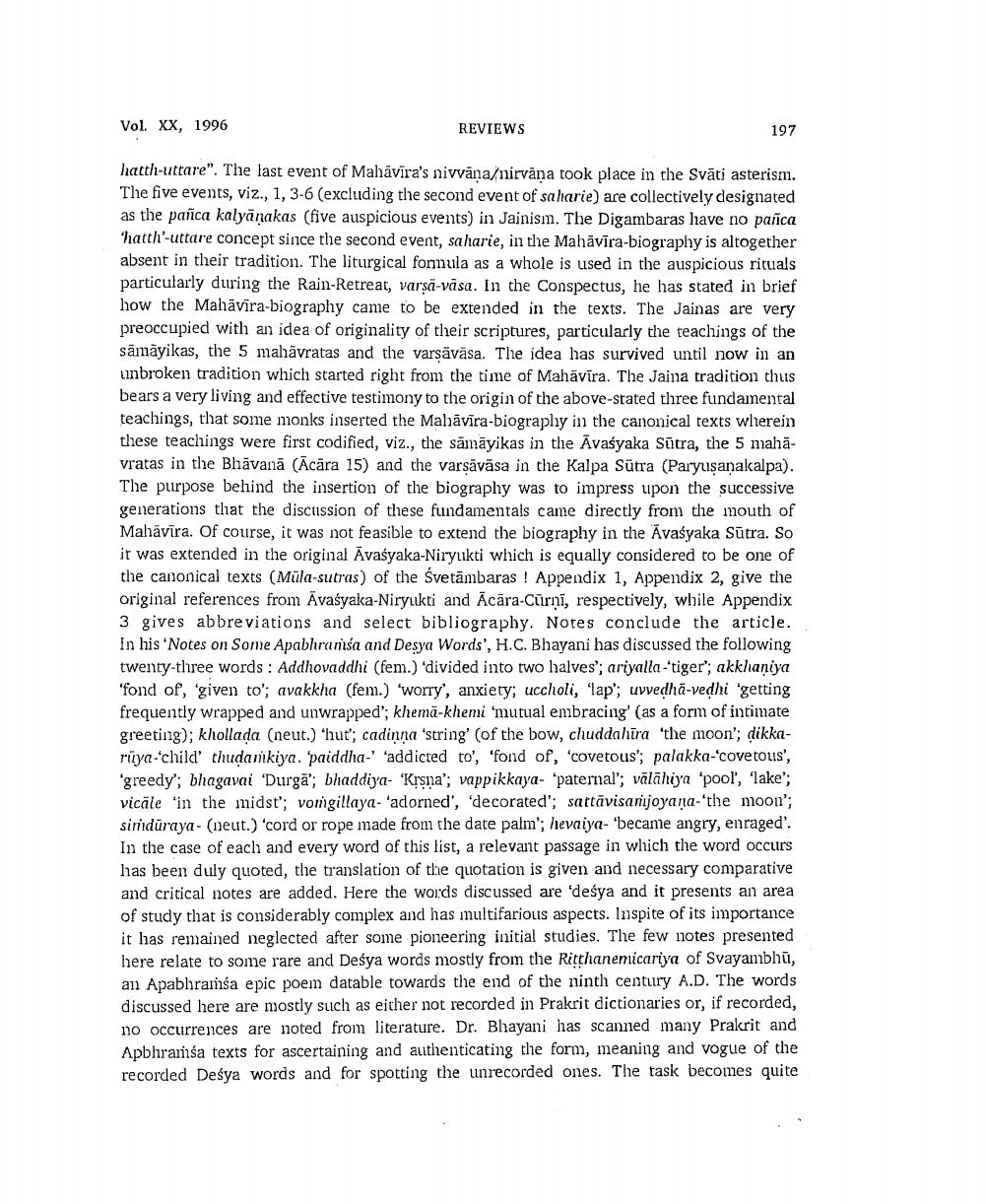________________
Vol. XX, 1996
REVIEWS
197
hatth-uttare". The last event of Mahavira's nivvana/nirvana took place in the Svāti asterism. The five events, viz., 1, 3-6 (excluding the second event of saharie) are collectively designated as the pañca kalyanakas (five auspicious events) in Jainism. The Digambaras liave no palica hatth'-uttare concept since the second event, saharie, in the Mahāvīra-biography is altogether absent in their tradition. The liturgical fornula as a whole is used in the auspicious rituals particularly during the Rain-Retreat, varsa-vasa. In the Conspectus, he has stated in brief how the Mahāvira-biography came to be extended in the texts. The Jainas are very preoccupied with an idea of originality of their scriptures, particularly the teachings of the sāmāyikas, the 5 mahāvratas and the varsāvāsa. The idea has survived until now in an unbroken tradition which started right from the time of Mahävira. The Jaina tradition thus bears a very living and effective testimony to the origin of the above-stated three fundamental teachings, that some monks inserted the Mahāvīra-biography in the canonical texts wherein these teachings were first codified, viz., the samāyikas in the Avasyaka Sūtra, the 5 mahavratas in the Bhāvanā (Ācāra 15) and the varsāvāsa in the Kalpa Sutra (Paryusanakalpa). The purpose behind the insertion of the biography was to impress upon the successive generations that the discussion of these fundamentals came directly from the mouth of Mahāvīra. Of course, it was not feasible to extend the biography in the Avaśyaka Sūtra. So it was extended in the original Avasyaka-Nirylikti which is equally considered to be one of the canonical texts (Müla-sutras) of the Svetāmbaras ! Appendix 1, Appendix 2, give the original references from Āvaśyaka-Niryukti and Ācāra-Cūrni, respectively, while Appendix 3 gives abbreviations and select bibliography. Notes conclude the article. In his 'Notes on Some Apabhramba and Desya Words', H.C. Bhayani has discussed the following twenty-three words: Addhovaddhi (fem.) 'divided into two halves'; ariyalla-tiger'; akklaniya 'fond of, given to'; avakkha (fem.) 'worry, anxiety; ucсholi, 'lap'; uvvedhā-vedhi 'getting frequently wrapped and unwrapped'; khema-khemi 'mutual embracing' (as a form of intimate greeting); khollada (neut.) 'hut; cadinna 'string' of the bow, chuddahīra 'the moon'; dikkarüya-'child' thudankiya. paiddha-' 'addicted to', 'fond of, 'covetous'; palakka-'covetous', 'greedy'; bhagavai 'Durga'; bhaddiya- 'Kysna'; vappikkaya- 'paternal'; vālāhiya 'pool', 'lake'; vicāle 'in the midst'; vongillaya-'adorned', 'decorated'; sattāvisanijoyana-'the moon'; sindūraya - (neut.) 'cord or rope made from the date palm'; hevaiya-'became angry, enraged'. In the case of each and every word of this list, a relevant passage in which the word occurs has been duly quoted, the translation of the quotation is given and necessary comparative and critical notes are added. Here the words discussed are 'desya and it presents an area of study that is considerably complex and has inultifarious aspects. Inspite of its importance it has remained neglected after some pioneering initial studies. The few notes presented here relate to some rare and Deśya words mostly from the Ritthanenicariya of Svayambhū, an Apabhramsa epic poem datable towards the end of the ninth century A.D. The words discussed here are mostly such as either not recorded in Prakrit dictionaries or, if recorded, no occurrences are noted from literature. Dr. Bhayani has scanned many Prakrit and Apbhramsa texts for ascertaining and authenticating the form, meaning and vogue of the recorded Desya words and for spotting the unrecorded ones. The task becomes quite




